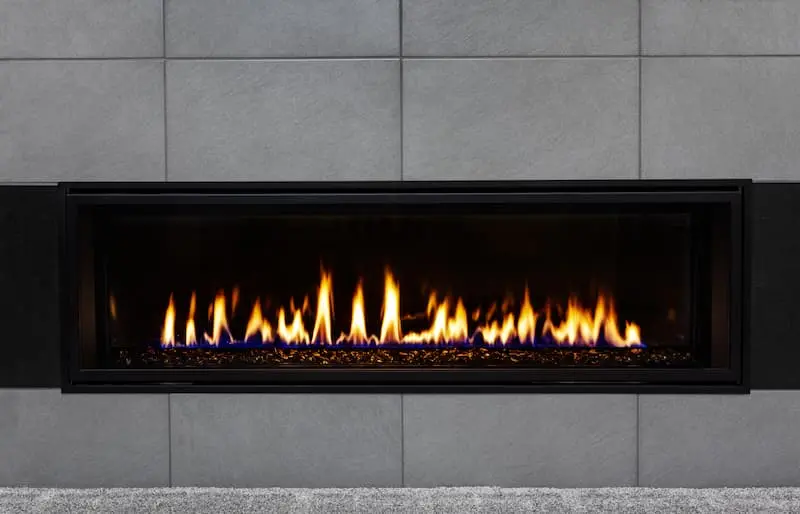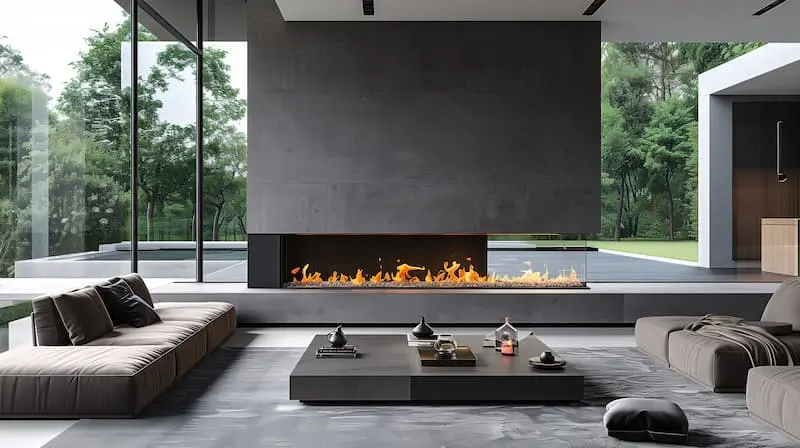The fireplace has evolved over the years from a utilitarian source of heat to a prominent place in interior design, often as the focal point in a room. However, fireplaces are not always eco-friendly, which presents homeowners who prioritize sustainability in interior design, with a dilemma: How can you make your fireplace more sustainable?
The good news is that with sleek design, and fireplace tech that is rapidly evolving, you can bask in the glow of your fireplace and feel good about your environmental footprint too.
Here is how you can make your fireplace more sustainable.
Thinking beyond traditional wood and gas fireplaces
The lure of a crackling fire in a wood-burning fireplace is undeniable, but over the years, homeowners have gravitated away from wood. Wood-burning fireplaces are notoriously bad for energy efficiency because of how they draw heat from a room. They also add pollutants to the air with smoke.
As homeowners looked for cleaner alternatives (both physically and environmentally), gas fireplaces became the popular choice. Although gas fireplaces are more eco-friendly relative to wood, they require fossil fuels, which doesn’t help reduce footprint.
As the marketplace evolves today through the lens of sustainability, there are exciting options for homeowners to choose from, that will not only support sustainability goals, but put an exclamation point on their style statement.
“We are at a really neat pivot point with sustainable fire features, where I think the industry is looking at what does a sustainable fire feature look like,” for all the stakeholders, from builders to retailers to homeowners, says Ron Schinnerer, sales and marketing leader for NetZero Fire.
What are the most sustainable fireplace options?
Three of the most popular and most sustainable fireplace options available include bioethanol, water vapor and electric.
How do you decide which one is for you? Schinnerer says that you need to think about placement, ability and convenience to provide the different fireplace fuel intake type (biofuel, water or electricity), and whether you prefer ribbon-like flames or a log-style fireplace.
Bio-ethanol fireplaces
Elegant, with ribbon-like flames, a bio-ethanol fireplace runs from bio-ethanol fuel, which is an alcohol derived from agricultural by-products, making it a sustainable choice.
It’s clean burning, and works with a ventless system, which means that it is also versatile, and can be installed in a variety of places, either built-in to the wall, a kitchen island or free standing.
The flames are real and heat-producing.
Water vapor fireplaces
Water vapor fireplaces, meanwhile, produce life-like, dancing ribbon flames, projected by mist particulate and an LED lighting system.
Like the bio-ethanol fireplace, it is clean-burning and ventless. Additionally, the flames are not heat-producing so are a suitable choice for households with pets and kids.
Electric fireplaces
Electric fireplaces have been around for some time, with plug-and-play units widely available.
Typically, electric fireplaces feature logs, as opposed to ribbon flames, and often have a built-in heater feature.
But while electric fireplaces offer convenience and sustainability, one criticism has traditionally been a less authentic-looking fireplace.
That’s changing, according to Schinnerer, and the future of sustainable fireplaces may very well be in electric, with high-definition holograms set to revolutionize the aesthetics of electric fireplaces.
“With holographic fireplaces, 20-inch depth has been added in the firebox,” mimicking “a very traditional fireplace, where you feel like flames are coming up from behind a log,” he says, “And it is phenomenal,” he says, “with flame pattern behind the log set and a flame pattern in front of the log set with that technology.”
Schinnerer feels that this is just the beginning of an inflection point in the conversation around sustainability and fireplaces, saying that in coming years, sustainability will be a basic part of the design of fireplaces, given the tech that is up-and-coming, led by holographic fireplaces with intricate, vivid flame patterns.
Improving sustainability with wood-burning and gas fireplaces
What if your heart is set on traditional wood-burning or gas fireplaces? There are ways to make your fireplace more sustainable.
- In general, make sure that your home is well insulated, with proper layers of insulation, as well as making sure that windows and doors are properly sealed. Any gap in the building envelope will let heat escape, making you expend more energy to maintain your indoor temperature at the desired level.
- Source wood locally, reducing transport from forests and fossil-fuel use.
- Make sure your fire burns efficiently, which will reduce smoke and emissions. To do this, ensure there is enough oxygen available in the room to aid with combustion, which can be accomplished simply by opening a window, or by having a special ventilation kit installed in your chimney.
- Burn hardwood only, that has been properly aged and dried. Burning trash, pressure-treated wood or other items will release toxic fumes into the air.
- Clean and maintain your chimney regularly.
- Put tempered glass doors on the fireplace. Not only does this up the style quotient, but they can also help to reduce heat loss.
- Use slow-burning wood.
- For gas fireplaces, use renewable natural gas.
- Include an insert to aid with energy efficiency, and to reduce release of particulate pollutants into the air.
Designing a sustainable fireplace surround
If you have a built-in fireplace, the surround is a key design element in the room. You make your fireplace more sustainable overall while elevating the aesthetic, by mindfully choosing surround materials and finishes.
A fireplace surround should mesh with the rest of your home’s style. Be mindful of other architectural features in the room, and plan your fireplace surround to complement them, rather than compete with them.
Different types of fireplaces will have different requirements for surround materials, depending on heat and energy source
Durability and heat resistance are two criteria, as well as texture, color and overall contribution to the aesthetic.
Mantel or no mantel? Both are popular. Running the same material the length of the wall for the surround is sleek and stylish and emphasizes the fireplace itself. Or, opt for a wooden mantel for a more rustic feel.
Some of the most sustainable and stylish options for fireplace surrounds include:
- Ceramic tile
- Natural stone, such as marble or granite
- Stacked stone
- Slate
- Brick









